Can I Feed My Cat Canned Sardines?
Cats are notorious for their picky eating habits, and many cat owners are constantly searching for new and healthy foods to add to their furry friend’s diet. One food that has been gaining popularity in recent years is canned sardines. While cats can definitely benefit from the high protein content and essential nutrients found in this fish, there are also some potential concerns that should be taken into consideration before incorporating it into their diet.
The Benefits of Feeding Cats Canned Sardines
Canned sardines are a great source of protein, which is essential for your cat’s overall health. They also contain a variety of other nutrients that can help support your cat’s immune system, and eye health, and even reduce inflammation in their body.
Additionally, sardines are a good source of omega-3 fatty acids which can help maintain healthy skin and coat. While cats require a high-protein diet, it’s important to note that they don’t need large quantities of food to meet their daily nutritional requirements.
This makes canned sardines an ideal supplement to their regular diet as they provide nutrition without adding too many calories. As an added bonus, feeding your cat canned sardines can also be a cost-effective way to add some variety to their meals.
Potential Concerns When Feeding Cats Canned Sardines
While there are many benefits to feeding cats canned sardines, there are also some potential concerns that pet owners should consider before incorporating them into their furry friend’s diet. One concern is the mercury levels in certain types of fish.
It’s important for cat owners to select safe and healthy canned sardine brands that undergo rigorous testing for contaminants like mercury. Another concern when feeding cats canned sardine is the added salt content found in some varieties of this fish.
Excess salt intake can lead to dehydration, as well as other health problems. To avoid this issue, pet owners should choose low-sodium varieties of canned sardines or rinse them thoroughly before feeding them to their cats.
Overall, canned sardines can be a healthy and cost-effective addition to a cat’s diet, but it’s important for pet owners to consider the potential concerns associated with this practice. By selecting safe and healthy canned sardine brands and monitoring their cat’s salt intake, owners can safely introduce this fish into their cat’s regular diet.
Can I Feed My Cat Canned Sardines?The Nutritional Benefits of Canned Sardines for Cats
Cats are obligate carnivores, which means they require a diet that is rich in animal protein. Fortunately, canned sardines provide an excellent source of protein that is easily digestible for cats. In fact, canned sardines contain approximately 25g of protein per 100g of fish.
This high-protein content makes canned sardines an ideal addition to your cat’s diet. But it’s not just the protein content that makes canned sardines so beneficial for cats.
These tiny fish also contain essential nutrients such as omega-3 fatty acids, vitamin D, calcium and phosphorus. Omega-3 fatty acids, in particular, play a vital role in maintaining a cat’s overall health by supporting their immune system and promoting healthy skin and coat.
Vitamin D is essential for strong bones and teeth while calcium and phosphorus work together to support healthy muscle function. Feeding your cat canned sardines can provide them with numerous nutritional benefits that promote their overall well-being.
Omega-3 Fatty Acids: The Key to Your Cat’s Health
One nutrient found in high quantities in canned sardines is omega-3 fatty acids – an essential fat that plays a crucial role in feline health. Cats cannot produce these fatty acids themselves; therefore, they need to get them from their diet.
Omega-3s help maintain healthy kidneys, vision, and cognitive function and can reduce inflammation throughout the body – including joint pain caused by arthritis. Additionally, they can help keep a cat’s skin moisturized from the inside out while reducing fur shedding.
Regular consumption of omega-3s has even been linked to lower rates of heart disease. Overall, feeding your cat canned sardines on occasion will not only be a delicious treat but also provide them with important nutrients like omega-3 fatty acids that keep them healthy and happy.
Potential Concerns of Feeding Cats Canned Sardines
Mercury Levels in Certain Types of Fish
While canned sardines can be a healthy addition to a cat’s diet, it’s important to be mindful of potential concerns, particularly when it comes to mercury levels. Some types of fish, such as tuna, tend to have higher levels of mercury than others. While canned sardines generally have lower levels of mercury compared to other types of fish, it’s still important for cat owners to select the right type and amount for their feline friend.
Mercury is a toxic heavy metal that can build up in a cat’s body over time. Ingesting too much mercury can lead to health issues such as neurological problems and damage to internal organs.
In order to avoid these risks, it’s recommended that cat owners limit the amount of canned sardines they feed their cats each week and choose brands that are known for low mercury levels. In general, it’s advised that cats consume no more than two servings of canned sardines per week as part of a balanced diet.
Tips on Selecting Safe and Healthy Canned Sardines for Cats
When selecting canned sardines for your cat, there are several things you should keep in mind. First and foremost, look for brands that use high-quality ingredients without any added preservatives or artificial flavors.
It’s also important to choose products that are specifically labeled as suitable for cats. Another factor to consider is the type of oil used in the product.
Many brands use soybean or vegetable oil which may not be ideal for cats due to their high omega-6 fatty acid content. Instead, look for products that use olive oil or other healthy oils with lower omega-6 fatty acid amounts.
Take note of any added salt or sodium content in the canned sardines. While small amounts are generally safe for cats, consuming too much salt can lead to dehydration and other health problems.
Opt for brands that use little to no added salt or sodium. By following these tips, cat owners can ensure that their pets are getting the best quality canned sardines possible while avoiding any potential health risks.
Can I Feed My Cat Canned Sardines?:How to Incorporate Canned Sardines into a Cat’s Diet
Feeding your cat canned sardines can provide many health benefits, but it is important to introduce them into their diet gradually and in moderation. Abruptly switching their food can cause digestive upset, so it’s best to start by mixing a small amount of sardines with their regular food.
Gradually increase the amount of sardines over time until they are eating a full serving of sardines mixed with their regular food. Another good way to incorporate canned sardines into your cat’s diet is by using them as a treat.
You can give your cat one or two pieces of sardine as a reward for good behavior or as an occasional snack. This will help keep their diet varied and interesting while providing them with important nutrients that they need to stay healthy.
Offer Suggestions on How to Introduce Canned Sardines into a Cat’s Diet
When introducing canned sardines into your cat’s diet, it is important to make sure that they are high quality and appropriate for your cat’s age and weight. Look for canned sardines that are packed in water or their own natural oils, rather than those containing added ingredients like salt or preservatives.
You could also try mixing the canned sardines with other foods that your cat already likes, such as wet food or cooked chicken. This will help them get used to the new flavor and texture before switching completely over to the new food.
Provide Serving Size Recommendations Based on A Cat’s Weight
The amount of canned sardine you should feed your cat depends on their weight. As a general rule, you should feed adult cats no more than one can of 85g per day if fed exclusively. For kittens and senior cats, adjust the serving size accordingly based on their weight.
It’s important not to overfeed your cat with canned sardines, as too much can lead to an upset stomach or even nutritional imbalances. Introducing canned sardines into your cat’s diet can provide them with many health benefits, but it’s important to do so in moderation and gradually.
Offer them as a treat or mix them with other foods they already enjoy and always check the serving size according to their weight. With these tips in mind, you can safely incorporate this tasty treat into your feline friend’s diet.
Other Considerations When Feeding Cats Canned Sardines
The Age Factor
When it comes to feeding cats canned sardines, age is an important factor to consider. Kittens may not have strong enough digestive systems to handle the high amount of protein that canned sardines provide.
For senior cats, canned sardines may be a good source of nutrition, but their digestive system and kidneys might not be able to handle fish every day. As with any new food item, it is always best to introduce it slowly and monitor your cat’s behavior and energy levels.
Pre-Existing Health Conditions
Cats with certain health conditions should avoid or limit their intake of canned sardines. For example, cats with hyperthyroidism should steer clear of fish because they contain high levels of iodine which can exacerbate the condition.
Similarly, cats with kidney disease need a low-protein diet, so feeding them too many sardines can cause health issues. It’s important for cat owners to consult their veterinarian before adding any new food items into their cat’s diet.
Alternative Options for Cat Owners
While canned sardines are a great source of nutrition for cats, some cat owners may prefer alternative options for various reasons such as budget constraints or preference for a different type of protein source. Cooked chicken or turkey meat is an excellent alternative as it still provides high-quality protein without the potential concerns found in fish products.
Additionally, some commercial brands offer complete diets that incorporate seafood ingredients such as salmon or tuna specifically formulated for cats that provide all the necessary nutrients they require. While feeding your cat canned sardines can be a great way to add variety and nutrition to their diet; age and pre-existing health conditions must be taken into consideration carefully.
Always make sure to check with your veterinarian and gradually introduce the new food item. If canned sardines are not an option, there are still many alternatives available to provide your furry friend with a balanced diet.
Conclusion
Feeding your cat canned sardines can be a healthy and nutritious addition to their diet. Sardines are a great source of protein and essential nutrients that can support your cat’s overall health.
However, it is important to keep in mind that not all canned sardines are created equal. You need to choose safe and healthy options for your feline friend.
When selecting canned sardines for your cat, opt for those packed in water instead of oil. This will minimize any added fats or calories in their diet.
Also, ensure that the sardines are boneless and skinless to avoid any choking hazards or digestive issues. Moreover, canned sardines should not replace your cat’s regular meals.
Instead, they should be used as an occasional treat or supplement to their diet. Overfeeding canned sardines to your cat can lead to obesity or other health issues such as mercury poisoning.
All in all, with the right precautions and moderation, feeding canned sardines to your cat can help promote a healthy lifestyle for them. So go ahead and let your feline friend enjoy this nutritious and delicious snack!




